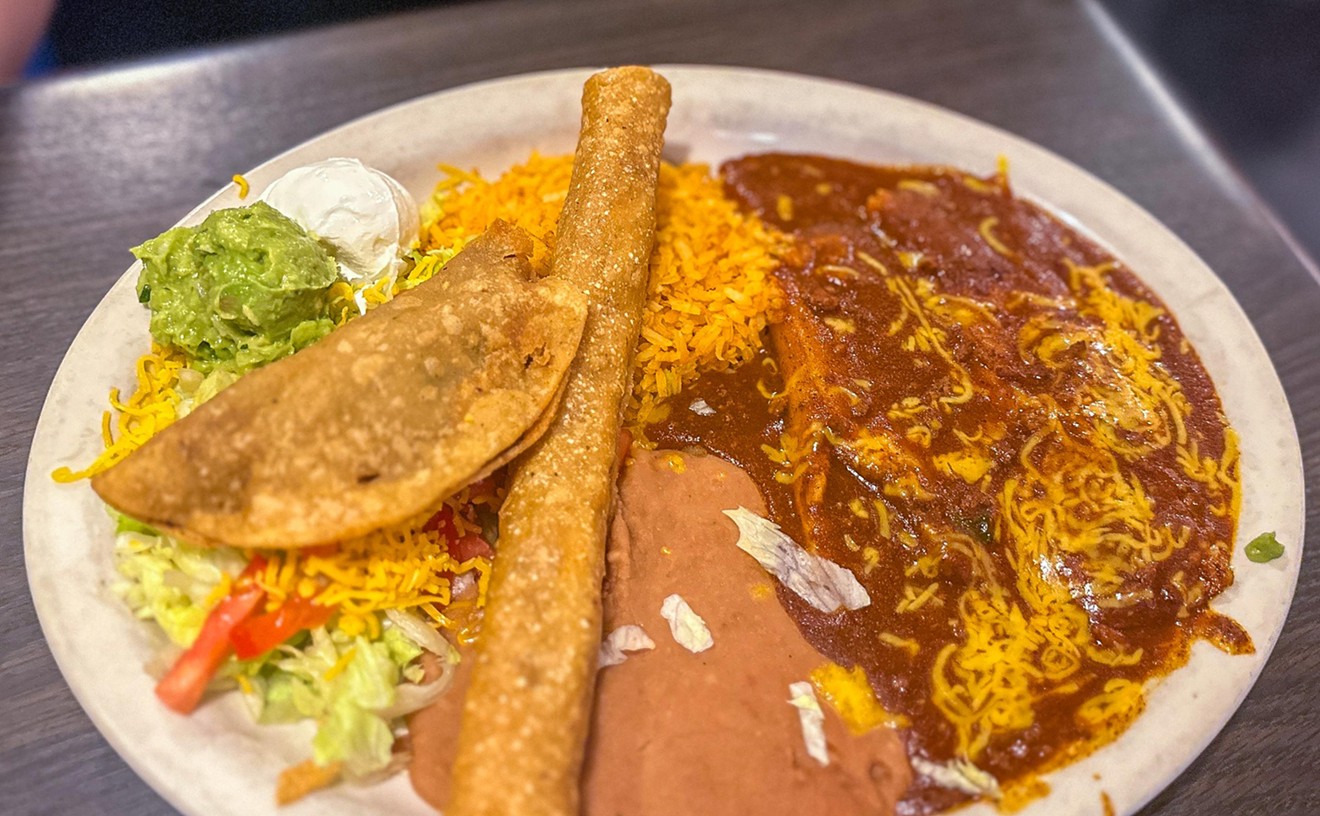I say this--actually write this--while staring at the dish that was just slipped onto our table. I don't know why I ordered it. Perhaps I just wanted to smugly reinforce the notion that I'm gastronomically eclectic.
It's Tei Tei's "specials" chalkboard hanging at the back of the open kitchen in this tiny, L-shaped restaurant that eggs you on. It dares you to put things in your mouth that, under normal circumstances, you would only read about while perusing National Geographic photos of a newly discovered rain forest culture relishing foie gras made from overfed termites.
That board plays on the gumption most of us experienced in college when we slipped the mescal worm between our lips. Only this time we are asked to walk a culinary high wire without the net of inebriation. After a couple of visits, no possible appearance on that board--not tartare of Dallas Gun Club pigeon-shoot squab, nor Ross Perot earlobe sashimi--would shock.
The thing that caught my eye, the one I'm now staring at, is "cristal fish sashimi." Maybe I was thinking of Champagne Cristal, that prestige drink from Louis Roederer. What if these fish had a sparkling effervescence, or even better, a bit of a kick?
Served atop a bed of crushed ice in a roughly hewn bowl, these tiny clear fish have barely discernable black eyes resembling runt poppy seeds. They're assembled in a loose clump, and I hesitate before pinching one with my chopsticks. Did this appetizer once make its home in someone's living-room fish tank?
These are the thoughts that give me pause. But I take a deep slug of sake, snatch one of those little fish, and plop it into my mouth. Its slightly sweet, clean brine flavor and firm, chewy texture are deeply pleasant.
We have a pesky 3-year-old at our table. So we decide to experiment and put a clump of these fish on her plate and gauge the results. Amazingly, she pinches a few in her tiny fingers and sucks them into her mouth like strands of spaghetti. Then she asks for more. I suppose she would eat earthworms too.
The only things more unusual than Tei Tei's chalkboard roster are the clay plates placed on the tables. These thick, charcoal-gray, curvaceous flaps have a deep trough in the center for food, or, as was the case with this 3-year-old, a place to make a pond of wasabi, soy sauce, and Japanese soda for the cristal fish to swim in. I asked our server what these distinctive place settings were, half expecting a brief rant on how the plate is a sculptured symbol representing the elegance of mindful eating. Instead, she pointed to the ceiling. "Roof tiles," she said through a partial smile.
We used those tiles as platforms for other fragments of exotica. Kisu tempura, a fish widely used in Japan for deep-frying because it retains its moist delicacy after cooking, came rolled with shiso leaf (from the perilla plant, a close relative of mint and basil) and impaled on long toothpicks. A trio of picks was placed in a small bowl filled with a sauce made from soy and bonito (a fish closely related to the mackerel and the tuna) stock. The crisp, sweet kisu was given breath by the aromatic shiso, while the sauce broadened it with a sea-washed savoriness.
Octopus sashimi--tender, white strips over crushed ice--was clean, moist, and not overly chewy. Silvery and stiff, grilled smelt were crisp yet succulent with a clump of sweet, pungent pulverized diakon radish to round it out.
But perhaps the most exotic Tei Tei item, Kobe beef, was not available on our visits. Demand for the stuff--an exclusive grade of meat known for its extraordinary tenderness, full flavor, and rich marbling--outstripped projections and supplies. So here we were, munching on sheer minnows, wondering what it's like to eat the perfect steak in steak country.
Produced in Kobe, Japan, Kobe beef comes from the rare Waygu cattle. These pampered beasts are massaged with sake and fed a diet that includes copious amounts of beer, leading a life not unlike your average well-heeled Cowboys fan.
But I wondered: In this era of efficient international airfreight systems, why would Tei Tei have such a lengthy Kobe blackout? (Our server told us a new shipment wouldn't arrive for several weeks). Is there a backlog of Waygu appointments at the Kobe Nordstrom spa?
No. Like all things desperately swell and wonderful--Spice Girls tickets, Quackers Beanie Babies with the tags still attached, face lifts that don't make you look like a ribbed condom stuffed with a bowling ball--Kobe beef is exceedingly rare. Only limited amounts slip into Los Angeles ports (Tei Tei says it snatches virtually every beefy scrap), where it has to survive a lengthy glare by USDA inspectors. (Texas A&M University reportedly has been immersed in Waygu crossbreeding research in an attempt to satisfy growing demand in Japan and elsewhere.)
One thing that's clear here, though, is that you don't have to drool over a Kobe steak ($75-$100) to have a meal of home-loan prices. During one visit, my companion ran into a business associate who had just finished dinner with five colleagues in a special room demarcated by stone walls, straw screens, and thick glass etched with ocean waves. They'd feasted on a tuna collar, an especially rich and succulent section of the fish between the head and the body, a cut often large enough to feed a group. "Our bill came to $800," he crowed in that gleeful tone that comes from larding up on an expense account. Amazingly, it seemed this bill wasn't bulked by sake: The gentlemen smoothly stepped into their shoes parked outside the room and skillfully avoided buffing the floor with their faces.
Tei Tei owner Teiichi Sakurai's sushi restaurant, the tightly crisp Teppo on Lower Greenville, doesn't drain the wallet like this robata bar does. But that doesn't mean Tei Tei shouldn't be pursued with passionate vigor. It's easy to come in, plunk yourself down with a sidekick at the robata bar (a display box filled with fresh fish, lobsters, and bottles of sake in crushed ice is recessed in the bar surface) in front of the bright, open kitchen and order a few items with some sake and not break 30 bucks. OK, 50 bucks. Filling up on little dishes ranging from $4.50 to $20.00 adds up fast.
Still, it's worth it when you consider you'll rarely stuff your mouth with offbeat stuff like this outside of Tokyo or an entomological buffet in the rain forest. And this is Dallas, for God's sake. At various times you'll find things like trigger fish sashimi, grilled baby barracuda, and sea snail. "We always try to serve food that is not available anywhere else in the U.S," boasts Sakurai.
That's why you'll experience flavors rarely tasted other places. The satisfying mussel-rice soup--tiny, sweet, tender mussels in a savory dashi (miso) broth with rice and fragrant strands of mitsupa (a Japanese herb loosely translated as three-leaves)--was six bucks.
Seared big-eyed tuna splashed in a ponzu vinaigrette and spread over a wide clay bowl of crushed ice came in at $8.95. Yet you could plunk this cash down and stop right here, filling the rest of your belly with the sheer potency of the experience. This was the silkiest, most delicate flesh ever to slip past lips--like lingerie for the tongue.
Grilled Atlantic silver cod was so moistly firm, it separated into clean segments. The gauzy-thin, crisp grill crust gave it a delicate bite, brilliantly framing the sweet, flavorful flesh.
There were some wide shots, though. Marinated grilled sea bass was slightly rubbery and light on flavor, while the sweet glazed duck, slow-cooked with potato and carrot in mirin and soy, was mushy, tired, and void of vibrant flavors. Crispy chicken breast rolls, wrapped in crispy nori (seaweed) with shiitake, were parched, though the intensely aromatic sesame leaves included in the bailing very nearly rescued the dish.
Surprisingly, the foie gras, pan-seared with sesame and soy, was shy on rich, nutty flavor. Though clean, its lushness seemed watered down, utterly lacking complex tastes.
Tei Tei (which means "little castle") is patterned after Tokyo's robata bars--restaurants that have been sprouting up on either coast for the last few years--which serve a selection of grilled meat and fish cooked over an oak-charcoal fired robata grill in addition to raw fish (there's Kobe beef sashimi as well). And the tightly structured, freshly supple dishes of exotica make an exuberant stab more than worth it--even if it requires leveraging your home. Some of life's building blocks just refuse to come cheap.
Tei Tei Robata Bar. 2906 North Henderson,(214) 828-2400. Open Tuesday-Sunday, 5:30-11 p.m. $$-$$$$










